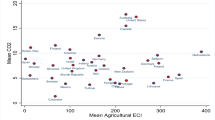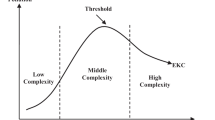Abstract
Brazil is a heterogenous country with respect to, among others, economic complexity, economic development and environmental quality. This paper examines the relationship between economic complexity and key environmental variables in Brazil. We deviate from the Environmental Kuznets Curve (EKC) literature by focusing on economic complexity instead of economic development alone to explain cross-section and time-series variation in a range of environmental variables. Our motivation for considering economic complexity as a main explanatory variable lies on the consideration that low economic complexity is associated to products which are peripheral on the product space. These are products which are less connected to other products, limiting the opportunities for other economic activities, and therefore limiting the impact on the environment. As economic complexity increases more opportunities are created, the product space becomes denser, and pollution increases. However, at a high enough level of economic complexity, the structural changes bring knowledge-intensive industries, which demands higher-skilled labour force and wider skills of occupations. At this point, economic complexity is associated to decreasing environmental degradation. Using panel data for Brazil we find that waste generation decreases, but forest fires increase with rising complexity. Complexity is not associated to more deforestation or air pollution.
Access this chapter
Tax calculation will be finalised at checkout
Purchases are for personal use only
Similar content being viewed by others
Notes
- 1.
Poverty headcount ratio at $3.20 a day (2011 PP) (% of population).
- 2.
More precisely, the ECI is calculated as the average complexity of products exported by a specific economy with international comparative advantage, weighted with the share of exports by the said economy.
- 3.
Aguiar et al. (2007) state that 70% of the total deforested area in the Amazon Basin is destined for cattle production. 13 and three per cent were transformed into temporary and permanent harvests, respectively.
- 4.
Oliveira et al. (2011) and Teixeira et al. (2012) add harvested area for the aforementioned agricultural products (in hectares) and cattle units per square kilometre as control variables. IPEA provides data on harvested area by agricultural products, but the panels are rather incomplete and lead to a drop in the number of observations when employed.
References
Aguiar APD, Câmara G, Escada MIS (2007) Spatial statistical analysis of land-use determinants in the Brazilian Amazonia: exploring intra-regional heterogeneity. Ecol Model 209(2):169–188
Al-Mulali U, Saboori B, Ozturk I (2015) Investigating the environmental kuznets curve hypothesis in Vietnam. Energy Policy 76:123–131
Antweiler W, Brian CR, Scott T (2001) Is free trade good for the environment? Am Econ Rev 91:877–908
Arrow K, Bolin B, Costanza R, Dasgupta P, Folke C, Helling CS, Jansson B-O, Levin S, Mailer K-G, Perrings C, Pimental D (1995) Economic growth, carrying capacity, and the environment. Science 268:520–521
Brown JC, Koeppe M, Coles B, Price KP (2005) Soybean production and conversion of tropical forest in the Brazilian Amazon: The case of Vilhena, Rondonia. AMBIO J Hum Environ 34(6):462–469
Castilho M, Menéndez M, Sztulman A (2012) Trade liberalization, inequality, and poverty in brazilian states. World Dev 40(4):821–835
Cole MA, Elliott RJR (2003) Determining the trade–environment composition effect: the role of capital, labor and environmental regulations. J Environ Econ Manage 46(3):363–383
Colusso MVDS, Parré JL, Almeida ES (2015) Degradação ambiental e crescimento econômico: A curva de Kuznets ambiental para o cerrado. Revista de Economia e Agronegócio–REA 10(3)
Dasgupta P, Laplante B, Wang H, Wheeler D (2002) Confronting the environmental Kuznets curve. J Econ Perspect 16(1):147–168
Fodha M, Zaghdoud O (2010) Economic growth and pollutant emissions in Tunisia: an empirical analysis of the environmental Kuznets curve. Energy Policy 38(2):1150–1156
Fosten J, Morley B, Taylor T (2012) Dynamic misspecification in the environmental Kuznets curve: evidence from CO2 and SO2 emissions in the United Kingdom. Ecol Econ 76:25–33
Goldenberg S, Roberts D (2015) Brazil announces massive reforestation and renewable energy plan with US. Guardian. Retrieved from https://www.theguardian.com/world/2015/jun/30/brazil-us-reforestation-forests-renewable-energy
Gomes SC, Braga MJ (2008) Desenvolvimento econômico e desmatamento na Amazônia legal: Uma análise econométrica. Number 103095 in 46th Congress, July 20–23, 2008, Rio Branco, Acre, Brasil. Sociedade Brasileira de Economia, Administração e Sociologia Rural (SOBER)
Grossman G, Krueger A (1991) Environmental impacts of a North American free trade agreement. Natl Bur Econ Res (Working Paper 3914)
Grossman GM, Krueger AB (1995) Economic growth and the environment. Q J Econ 110(2):353–377
Hausmann R, Hidalgo CA, Bustos S, Coscia M, Simoes A, Yildirim MA (2014) The atlas of economic complexity: map** paths to prosperity. MIT Press
Hidalgo CA, Hausmann R (2009) The building blocks of economic complexity. Proc Natl Acad Sci 106(26):10570–10575
Holtz-Eakin D, Selden TM (1995) Stoking the fires? CO2 emissions and economic growth. J Public Economics 57(1):85–101
IBRD (1992) World Development Report 1992. Development and the environment. Oxford University Press, New York
Iwata H, Okada K, Samreth S (2010) Empirical study on the environmental Kuznets curve for CO2 in France: the role of nuclear energy. Energy Policy 38(8):4057–4063
Jaffe AB, Newell RG, Stavins RN (2003) Technological change and the environment. Handb Environ Econ 1:461–516
Jalil A, Feridun M (2011) The impact of growth, energy and financial development on the environment in china: a cointegration analysis. Energy Econ 33(2):284–291
Jalil A, Mahmud SF (2009) Environment Kuznets curve for CO2 emissions: a cointegration analysis for china. Energy Policy 37(12):5167–5172
Liu M, Huang Y, ** Z, Ma Z, Liu X, Zhang B, Liu Y, Yu Y, Wang J, Bi J, Kinney PL (2017) The nexus between urbanization and PM2.5 related mortality in China. Environ Pollut 15–23
Lo VI, Hiscock M (2014) The rise of the BRICS in the global political economy: changing paradigms? Edward Elgar Publishing
Managi S, Jena PR (2008) Environmental productivity and Kuznets curve in India. Ecol Econ 65(2):432–440
Margulis S (2003) Causas do desmatamento da Amazônia Brasileira, 1a edição. Banco Mundial. Brasília, 100p
Mazzetti C (2016) 5 alarming facts about Amazon forest fires. Greenpeace International. Retrieved from http://www.greenpeace.org/international/en/news/Blogs/makingwaves/5-alarming-facts-about-amazon-forest-fires-deforestation/blog/57406/
Mills JH, Waite TA (2009) Economic prosperity, biodiversity conservation, and the environmental Kuznets curve. Ecol Econ 68(7):2087–2095
Miragaya J (2008) Demanda mundial de carne bovina tem provocado o desmatamento na Amazônia. T&C Amazônia, ano VI(14)
Nasir M, Rehman FU (2011) Environmental Kuznets curve for carbon emissions in Pakistan: an empirical investigation. Energy Policy 39(3):1857–1864
Observatory of Economic Complexity (2017) Brazil economic complexity ranking. Retrieved from http://atlas.media.mit.edu/en/profile/country/bra/#Economic_Complexity_Ranking
Oliveira RC, Almeida E, Freguglia RS, Barreto RCS (2011) Desmatamento e crescimento econômico no Brasil: Uma análise da curva de Kuznets ambiental para a Amazônia legal. Rev Economia Sociologia Rural 49(3):709–739
Panayotou T (1993) Empirical tests and policy analysis of environmental degradation at different stages of economic development. International Labour Organization (292778)
Perman R, Stern DI (2003) Evidence from panel unit root and cointegration tests that the environmental Kuznets curve does not exist. Aust J Agric Resour Econ 47(3):325–347
Saboori B, Sulaiman J (2013) Environmental degradation, economic growth and energy consumption: evidence of the environmental Kuznets curve in Malaysia. Energy Policy 60:892–905
Santos RBN, Diniz MB, Diniz MJT, Rivero SLM, Oliveira Jr JN (2008) Estimativa da curva de Kuznets ambiental para a Amazônia legal. Number 113968 in 46th Congress, July 20–23, 2008, Rio Branco, Acre, Brasil. Sociedade Brasileira de Economia, Administração e Sociologia Rural, SOBER
Selden TM, Song D (1994) Environmental quality and development: Is there a Kuznets curve for air pollution? J Environ Econ Manage 27:147–162
Shafik N, Bandyopadhyay S (1992) Economic growth and environmental quality: time series and crosscountry evidence. In Background paper for the World Development Report 1992. The World Bank, Washington DC
Sousa AG, Araujo AA, Santos RBND, Santos FTPD, Diniz MB (2008) Sustentabilidade e meio ambiente no Brasil: Uma análise a partir da curva de Kuznets. Number 113968 in 46th Congress, July 20–23, 2008, Rio Branco, Acre, Brasil. Sociedade Brasileira de Economia, Administração e Sociologia Rural, SOBER
Stern DI (2002) Explaining changes in global sulfur emissions: An econometric decomposition approach. Ecol Econ 42:201–220
Stern DI (2004) The rise and fall of the environmental Kuznets curve. World Dev 32(8):1419–1439
Stern DI (2017) The environmental Kuznets curve after 25 years. J Bioecon 19:7–28
Stern DI, Common MS (2001) Is there an environmental Kuznets curve for Sulfur? J Environ Econ Manage 41(2):162–178
Stern DI, Common MS, Barbier EB (1996) Economic growth and environmental degradation: the environmental Kuznets curve and sustainable development. World Dev 24(7):1151–1160
Suri V, Chapman D (1998) Economic growth, trade and the energy: implications for the environmental Kuznets curve. Ecol Econ 25:195–208
Tao S, Zheng T, Lianjun T (2008) An empirical test of the environmental Kuznets curve in china: a panel cointegration approach. China Econ Rev 19(3):381–392
Teixeira RFAP, Bertella MA, Almeida LTD (2012) Curva de Kuznets ambiental para o estado de Mato Grosso. Análise Econômica 313–337
United Nations (2015) Transforming our world: the 2030 agenda for sustainable development, 70th Session, UN Doc, A/Res/70/1
Vera-Diaz MC, Kaufmann RK, Nepstad DC, Schlesinger P (2008) An interdisciplinary model of soybean yield in the Amazon Basin: the climatic, edaphic, and economic determinants. Ecol Econ 65(2):420–431
Watts J (2012) Brazil’s Amazon rangers battle farmers’ burning business logic. Guardian. Retrieved from https://www.theguardian.com/environment/2012/nov/14/brazil-amazon-rangers-farmers-burning
World Bank (2017) Urban population, percentage of total. Retrieved from http://data.worldbankorg/indicator/SP.URB.TOTL.IN.ZS?locations=BR
Author information
Authors and Affiliations
Corresponding author
Editor information
Editors and Affiliations
Appendix
Appendix
1.1 Data Sources
Table 8 contains the sources of all the data employed in our study. This includes both data of variables included in the regressions, and data of variables used to construct or transform variables that could not be found in the necessary disaggregation level. The variables are listed in alphabetical order.
1.2 Descriptive Statistics
Tables 9, 10, 11 and 12 provide descriptive statistics for our five panels. Since we find robust evidence for inverted U-shaped relationships between income per capita and solid waste generation, deforestation and forest fires in Sect. 4, the statistics on income per capita are needed to determine whether the turning points of the EKCs lie within the range.
Rights and permissions
Copyright information
© 2020 Springer Nature Switzerland AG
About this chapter
Cite this chapter
Swart, J., Brinkmann, L. (2020). Economic Complexity and the Environment: Evidence from Brazil. In: Leal Filho, W., Tortato, U., Frankenberger, F. (eds) Universities and Sustainable Communities: Meeting the Goals of the Agenda 2030. World Sustainability Series. Springer, Cham. https://doi.org/10.1007/978-3-030-30306-8_1
Download citation
DOI: https://doi.org/10.1007/978-3-030-30306-8_1
Published:
Publisher Name: Springer, Cham
Print ISBN: 978-3-030-30305-1
Online ISBN: 978-3-030-30306-8
eBook Packages: Earth and Environmental ScienceEarth and Environmental Science (R0)




